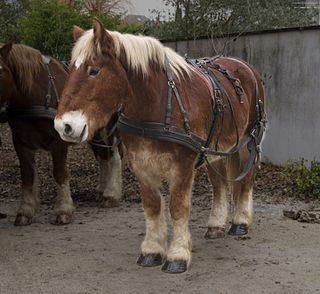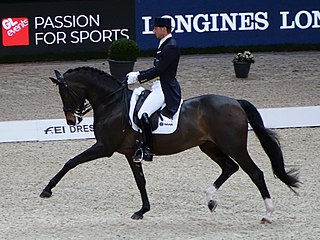
The Peruvian Horse is a breed of light saddle horse known for its smooth ride. It is distinguished by a natural, four-beat, lateral gait called the paso llano. This breed is protected by the Peruvian government through Decree number 25919 of Peru enacted on November 28, 1992, and has been declared a Cultural Heritage of the Nation by the National Institute of Culture (INC). Due to the isolation suffered for about 400 years and the selection made by their breeders, this breed is very particular in their body proportions and an ambling gait or "paso llano" that is characteristic. It is typical of the northern Peruvian regions of the country from which it originated. Trujillo city is considered the cradle of typical Peruvian Horses.

Horses can use various gaits during locomotion across solid ground, either naturally or as a result of specialized training by humans.

The Icelandic horse is a breed of horse developed in Iceland. Although the horses are small, at times pony-sized, most registries for the Icelandic refer to it as a horse. Icelandic horses are long-lived and hardy. In their native country they have few diseases; Icelandic law prevents horses from being imported into the country and exported animals are not allowed to return. In addition to the gaits of walk, trot, and canter/gallop typical of other horse breeds, many Icelandic horses can also do the tölt and the flying pace. The only breed of horse in Iceland, they are also popular internationally, and sizable populations exist in Europe and North America. The breed is still used for traditional sheepherding work in its native country, as well as for leisure, showing, and racing.

A palfrey is a type of horse that was highly valued as a riding horse in the Middle Ages. It was a lighter-weight horse, usually a smooth gaited one that could amble, suitable for riding over long distances. Palfreys were not a specific breed as horse breeds are understood today.

The Tersk or Tersky is a Russian breed of light riding horse of Arab type. It was bred at the Tersk Stud in Stavropol Krai in the North Caucasus between about 1925 and 1940.

The Ukrainian Riding Horse or Ukrainian Saddle Horse is a modern Ukrainian breed of warmblood sport horse. Breeding began in the years after the Second World War at the stud farm of Dnipropetrovsk in central Ukraine – at that time in the USSR – and later expanded to three other state stud farms. It derives from cross-breeding of Hanoverian, Thoroughbred and Trakehner stallions with local mares or with Hungarian Furioso, Gidran Arab or Nonius mares. It incorporates the last bloodlines of the extinct Orlov-Rostopchin or Russian Saddle Horse. It was bred to compete in show jumping, three-day eventing and dressage, but is also suitable as a general riding horse.

The Knabstrupper or Knabstrup is a Danish breed of warmblood horse. It is principally a riding horse, but is also used as a harness horse and as a circus animal.

An ambling gait or amble is any of several four-beat intermediate horse gaits, all of which are faster than a walk but usually slower than a canter and always slower than a gallop. Horses that amble are sometimes referred to as "gaited", particularly in the United States. Ambling gaits are smoother for a rider than either the two-beat trot or pace and most can be sustained for relatively long periods, making them particularly desirable for trail riding and other tasks where a rider must spend long periods in the saddle. Historically, horses able to amble were highly desired for riding long distances on poor roads. Once roads improved and carriage travel became popular, their use declined in Europe but continued in popularity in the Americas, particularly in areas where plantation agriculture was practiced and the inspection of fields and crops necessitated long daily rides.

The Trait Breton is a French breed of draught horse. It originated in Brittany, in north-west France, from cross-breeding of local horses with various other breeds. It is strong and muscular, and often has a chestnut coat.

The Swedish Warmblood or Swedish Half-bred is a Swedish breed of warmblood horse. It was originally bred as a cavalry horse at the Strömsholm, Ottenby and Flyinge studs. In the twentieth century it became a general-purpose riding and sport horse. It performs well in dressage, show-jumping and three-day eventing, and also as a harness horse.

The Novokirghiz or New Kirghiz is a modern Kyrgyz breed of horse. It was developed in the Kirghiz Soviet Socialist Republic in the mid-twentieth century through cross-breeding of the traditional Kyrgyz Horse of the region with introduced horses of Thoroughbred, Don and Anglo-Don stock.

The Gelderlander is a Dutch breed of warmblood horse. It was bred in the province of Gelderland in the Netherlands as a carriage horse capable also of farm work. It declined in popularity in the mid-twentieth century. In 1965 it was one of the foundation breeds of the Dutch Warmblood or KWPN, the other being the heavier Groninger horse from the north. It is registered in a division of the Royal Dutch Warmblood Horse Studbook, which also has divisions for the Dutch Warmblood and for the Dutch Harness Horse.
The Tawleed is a Sudanese breed of sport horse. It derives from the Sudanese Country-Bred through cross-breeding with imported blood horses, principally of Thoroughbred stock. It is found mainly in the Khartoum region of Sudan.

The Rottaler is a German breed of riding and carriage horse of heavy warmblood type. The name derives from that of the Rottal, the valley of the Rott in the Landkreis of Rottal-Inn in south-eastern Bavaria. It is critically endangered. The Bavarian Warmblood derives from it.
The Nooitgedachter is a South African breed of riding horse. It is the result of a selective breeding programme established in 1952 to preserve the Basutho Pony of Lesotho. It was later decided to give it a different name; it was at first called the Nooitgedacht Pony, named for the Proefplaas Nooitgedacht, the research station near Ermelo in Eastern Transvaal where it was bred; it was later called the Nooitgedacht Horse until the present name was chosen. It is a rare breed, with only about 400 purebreds in existence.
The Vlaamperd is a South African breed of light draught or harness horse; it is also suitable for riding and is used in dressage. It was bred in the Western Cape region of South Africa in the early twentieth century, and resulted from cross-breeding of local mares with imported European stallions, particularly Friesians. The horses are usually black, though mares may be dark seal brown. A stud-book was started in 1983.

Five-gaited horses are notable for their ability to perform five distinct horse gaits instead of simply the three gaits, walk, trot and canter or gallop common to most horses. Individual animals with this ability are often seen in the American Saddlebred horse breed, though the Icelandic horse also has five-gaited individuals, though with a different set of gaits than the Saddlebred.
The Sudanese Country-Bred is a Sudanese breed of light riding horse. It was bred in the twentieth century by cross-breeding local mares of Barb type with imported Arab or Thoroughbred stallions.














